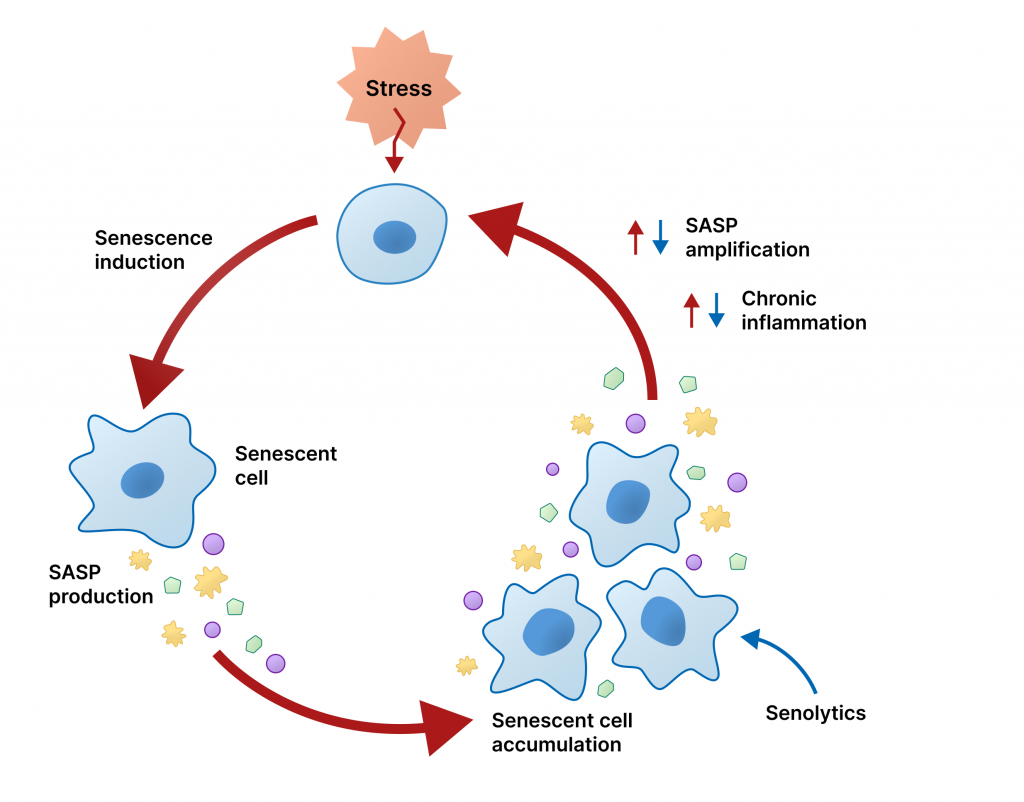- Kirkland JL, Tchkonia T. Senolytic drugs: from discovery to translation. J Intern Med. 2020 Nov;288(5):518-536. doi: 10.1111/joim.13141. Epub 2020 Aug 4. PMID: 32686219; PMCID: PMC7405395.
- Chaib, S., Tchkonia, T. & Kirkland, J.L. Cellular senescence and senolytics: the path to the clinic. Nat Med 28, 1556–1568 (2022). https://doi.org/10.1038/s41591-022-01923-y
- Yousefzadeh MJ, Zhu Y, McGowan SJ, Angelini L, Fuhrmann-Stroissnigg H, Xu M, Ling YY, Melos KI, Pirtskhalava T, Inman CL, McGuckian C, Wade EA, Kato JI, Grassi D, Wentworth M, Burd CE, Arriaga EA, Ladiges WL, Tchkonia T, Kirkland JL, Robbins PD, Niedernhofer LJ. Fisetin is a senotherapeutic that extends health and lifespan. EBioMedicine. 2018 Oct;36:18-28. doi: 10.1016/j.ebiom.2018.09.015. Epub 2018 Sep 29. PMID: 30279143; PMCID: PMC6197652.
- Limbad C, Doi R, McGirr J, Ciotlos S, Perez K, Clayton ZS, Daya R, Seals DR, Campisi J, Melov S. Senolysis induced by 25-hydroxycholesterol targets CRYAB in multiple cell types. iScience. 2022 Feb 2;25(2):103848. doi: 10.1016/j.isci.2022.103848. PMID: 35198901; PMCID: PMC8851282.
- Ogrodnik M, Evans SA, Fielder E, Victorelli S, Kruger P, Salmonowicz H, Weigand BM, Patel AD, Pirtskhalava T, Inman CL, Johnson KO, Dickinson SL, Rocha A, Schafer MJ, Zhu Y, Allison DB, von Zglinicki T, LeBrasseur NK, Tchkonia T, Neretti N, Passos JF, Kirkland JL, Jurk D. Whole-body senescent cell clearance alleviates age-related brain inflammation and cognitive impairment in mice. Aging Cell. 2021 Feb;20(2):e13296. doi: 10.1111/acel.13296. Epub 2021 Jan 20. PMID: 33470505; PMCID: PMC7884042.
- Dungan, C. M., Murach, K. A., Zdunek, C. J., Tang, Z. J., VonLehmden, G. L., Brightwell, C. R., Hettinger, Z., Englund, D. A., Liu, Z., Fry, C. S., Filareto, A., Franti, M., & Peterson, C. A. (2021). Deletion of SA β-Gal+ cells using senolytics improves muscle regeneration in old mice. Aging Cell, 00, e13528. https://doi.org/10.1111/acel.13528
- Justice JN, Nambiar AM, Tchkonia T, LeBrasseur NK, Pascual R, Hashmi SK, Prata L, Masternak MM, Kritchevsky SB, Musi N, Kirkland JL. Senolytics in idiopathic pulmonary fibrosis: Results from a first-in-human, open-label, pilot study. EBioMedicine. 2019 Feb;40:554-563. doi: 10.1016/j.ebiom.2018.12.052. Epub 2019 Jan 5. PMID: 30616998; PMCID: PMC6412088.
Senescent cells accumulate with age and promote tissue deterioration. They are implicated in many harmful age-related health conditions. Senolytics have the unique ability to selectively target and eliminate senescent cells.
As the aging population skyrockets, leading researchers in the field of aging are left with the heavy task of developing effective longevity interventions before the number of individuals succumbing to age-related conditions explodes. One of the primary drivers of aging that has garnered extensive research is cellular senescence – a critical dormant state where cells cease proliferation. Studies have linked the accumulation of these growth-arrested cells to a myriad of age-related conditions, which have been shown to drive chronic systemic inflammation, a primary driver of aging. In the last decade, scientists have identified a class of promising therapeutic compounds known as senolytics, which selectively target and eliminate senescent cells.
The Significance of Senolytics
As we age, our genetic blueprints (DNA) accumulate damage as a consequence of chronic inflammation, mitochondrial dysfunction, imprecise DNA replication, and oxidative stress. Enough DNA damage triggers a stress response that forces cells to transition into an irreversible senescent state. The continuous sprouting of senescent cells throughout the body during aging eventually cripples major organs, compromising overall health.
Senescent cells are thought to be a safety mechanism to stop the progression of tumorigenesis and are also involved in injury recovery. As such, they are usually eliminated by the immune system. However, as we grow older, our immune system declines, allowing senescent cells to accumulate. Moreover, senescent cells are able to evade programmed cell death (apoptosis) through anti-apoptotic networks. Senolytics, however, have the unique ability to target and shut down these anti-apoptotic pathways and make up for immune system deficiencies, leading to fewer senescent cells and ultimately hindering the progression of age-related conditions.
Notably, senolytics are multifaceted and can eliminate senescent cells throughout the body, including those accumulated in the liver, lungs, brain, muscles, heart, and bones. Rather than targeting individual health conditions, senolytics target what has been called the root cause of aging – senescence – which has been shown to affect all major classes of tissue. With this in mind, senolytics could potentially target many aging mechanisms simultaneously, eliminating the need for multiple treatments.

Senolytic Applications
Our brains are the seat of extensive vital networks responsible for the maintenance and health of our senses, behavior, and motor functions. Thus, finding ways to delay brain aging is key to healthy longevity. Increased oxidative stress and inflammation arising from senescent cells are primary drivers of accelerated brain aging. Fortunately, some senolytics have been found to exert potent anti-oxidative and anti-inflammatory effects, extending lifespan and attenuating cognitive dysfunction and depression in rodent models.
As we age, the structural integrity of our bones and muscles inevitably deteriorates, making our bones brittle and our muscles weak. Furthermore, research has shown that having more senescent cells tarnishes muscle tissue and increases frailty in older adults. However, studies demonstrate that eliminating senescent cells through senolytics enhances muscle regeneration and restores age-related muscle loss. Given the success of these studies, senolytics are undergoing clinical trials to evaluate their effectiveness in mitigating frailty in older adults.